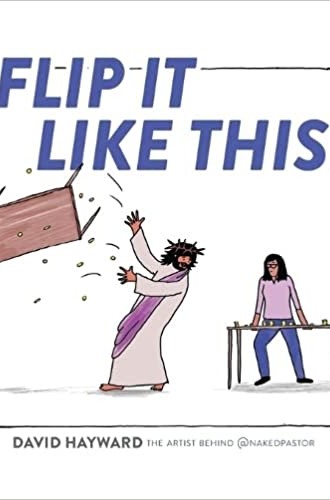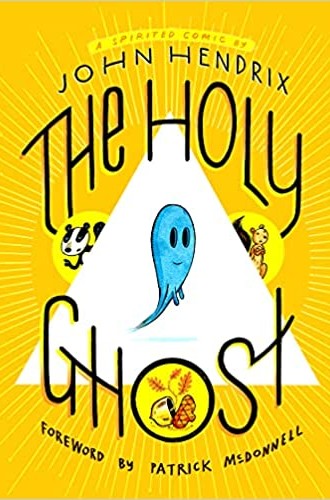Drawing God
A graphic novel about the Hebrew God, a collection of cartoons about Jesus, and a comic strip about the Holy Ghost
“Studying the Torah at Hebrew day school,” writes Liana Finck, “I thought of it mostly as a portrait of one childlike (and therefore relatable) character full of feelings and desires: God.” Let There Be Light is a marvelous exercise in visual hermeneutics. It tells the story of Genesis as a graphic novel, incorporating sparks of insight from the Talmud and a solid feminist streak. (Also, there are mermaids and unicorns.)
Like Finck, the God of Let There Be Light is a woman. She’s an artist who creates the world to stem the tide of her immense loneliness. She’s brilliant and kind and tends toward depression, especially when she finds that humans aren’t as great as she’d hoped. She struggles to see her image in them. They insist on believing that she is “a stern old man with a beard”—so much so that she eventually pretends to be one.
Read our latest issue or browse back issues.
From the start, there are problems with God’s artwork. Lilith, created from the soil with Adam, rejects his patriarchal view of the world and slinks away. God creates a more subservient woman, this time from Adam’s rib. Later, Lilith (in the form of a serpent) visits Noah’s wife and proclaims:
God is a woman. Deep in his heart, your husband knows this. To avoid confronting the truth, he doesn’t let himself really look at you. He pretends you’re not as smart as he is. He gives you all the hardest work, which he later pretends was “unimportant” work, beneath his notice.
Noah’s wife ponders these words for a moment. Then she jumps onto a chair and screams, “Noah!!! A snake!”
Abraham leaves home, takes a train to Philadelphia, and goes to art school. But his creations aren’t what God had hoped for. When God asks him to sacrifice Isaac decades later, she explains: “I want you to understand the destructive urge, as well as the creative one.” The struggle between creation and destruction is a theme that runs throughout the book, launched by Cain’s murder of Abel.
The theological heart of Let There Be Light is an explanation of tsimtsum, a kabbalistic teaching of the 16th-century rabbi Isaac Luria. Before God could create the world, Finck explains, she had to make room by carving out a little space inside herself. As the world grew, that space grew too—and God began to contract. God got smaller and smaller until she was barely perceptible to the world, except through the stories she left behind. “For only in God’s absence can we begin to comprehend her love for us. Only then can we see her in ourselves.”
After this point, God appears only sporadically. She helps Isaac complete his seven years of work for Laban, and she helps Joseph get out of prison by interpreting dreams. But mostly she is absent. Let There Be Light ends where it began: with God and humans struggling to see themselves mirrored in each other.
The cartoon collection Flip It Like This! is also about how people fail to reflect God’s image. David Hayward (also known as NakedPastor) served as a pastor for 30 years before becoming a cartoonist. His cartoons, which are popular among progressive Christians, focus on the church’s failure to embody God’s love—particularly toward women and LGBTQ people.
In one cartoon, a man asks, “Pastor, what’s our policy on abuse?” The pastor replies, “Well, we do spiritual and emotional, but we try to avoid physical and sexual.” In another, a theology book is tied down in a bed, surrounded by physicians and security guards. “We had to restrain him,” says one of the doctors. “He was hurting a lot of people.”
Jesus wears a crown of thorns in most of the cartoons, and the church hurts him repeatedly. He gets locked up in a church-shaped jail cell; he sleeps on the floor after the church pushes him out of their shared bed; he sits in the passenger seat and laments that the church no longer lets him drive. Jesus and the church sit on a therapist’s couch together, complaining, “We hardly have anything in common anymore!”
Jesus’ interactions with the church are subtle and subversive. He secretly alters church signs during the night, stealing the “not” from a “gays not allowed” sign and crossing out the “Christian” on a sign identifying a church as “evangelical Christian.” He says to a group of Christians, “The difference between you and me is you use scripture to determine what love means and I use love to determine what scripture means.”
The message of these cartoons is that the church has lost its way and Jesus won’t directly intervene. He does, however, spend a lot of time offering kindness to LGBTQ people. When a man nervously says, “Sorry Jesus, but I think I’m gay,” Jesus reassures him with, “Dude! Relax! I knew that long before you did.” When a flock of white sheep throw stones at a rainbow-colored sheep, Jesus puts his own body in the way.
The Jesus of Flip It Like This! looks a lot like the way a former evangelical might envision the ideal pastor. He doesn’t give up on the church, but neither does he confront its failings in a blaze of showy anger. He gently pushes against its abuses but spends most of his time comforting those who have been hurt by it.
After reading Let There Be Light and Flip It Like This! I felt rather pessimistic about the state of the world and God’s involvement in it. I needed an infusion of hope. Thankfully, I found it in The Holy Ghost, a collection of comic strips by John Hendrix that appeared on Tumblr as “The Adventures of the Holy Ghost.” The title character is a friendly blue ghost who both comforts and challenges.
The protagonist is a squirrel who asks deep questions about theodicy, ethics, beauty, and truth. He isn’t sure why he should believe in God, and it doesn’t help that he is frequently pestered by a pious, know-it-all badger who resembles an evangelical preacher. The squirrel longs for revelation but seeks certainty. He wants church to be relaxing and fulfilling, like a good brunch. He vacillates between existential crises and pious platitudes. In other words, he isn’t too different from the average mainline Protestant.
The Holy Ghost always shows up for the squirrel, offering clues about God’s character, deconstructing the faulty premises of the squirrel’s queries, and often simply serving as a gentle companion. The Holy Ghost knows from personal experience that God’s actions are not always predictable but God’s enduring love is. Yes, God created parasitic wasps on the fifth day, the Holy Ghost explains as the squirrel struggles with the existence of evil, but “well, he made kitties right after to balance things out.”
In one of the book’s most poignant moments, the squirrel is in the hospital, terrified of dying. He laments the pain and fear of being trapped in a body that is subject to finitude. He asks rhetorically, “Who would willingly choose this horrid condition?” The Holy Ghost replies: “Hmm. Only one person comes to mind.”
On Tumblr, Hendrix describes his Holy Ghost series as “a semi-blasphemous sketchbook comic.” But to me, it reads more like a gospel.









